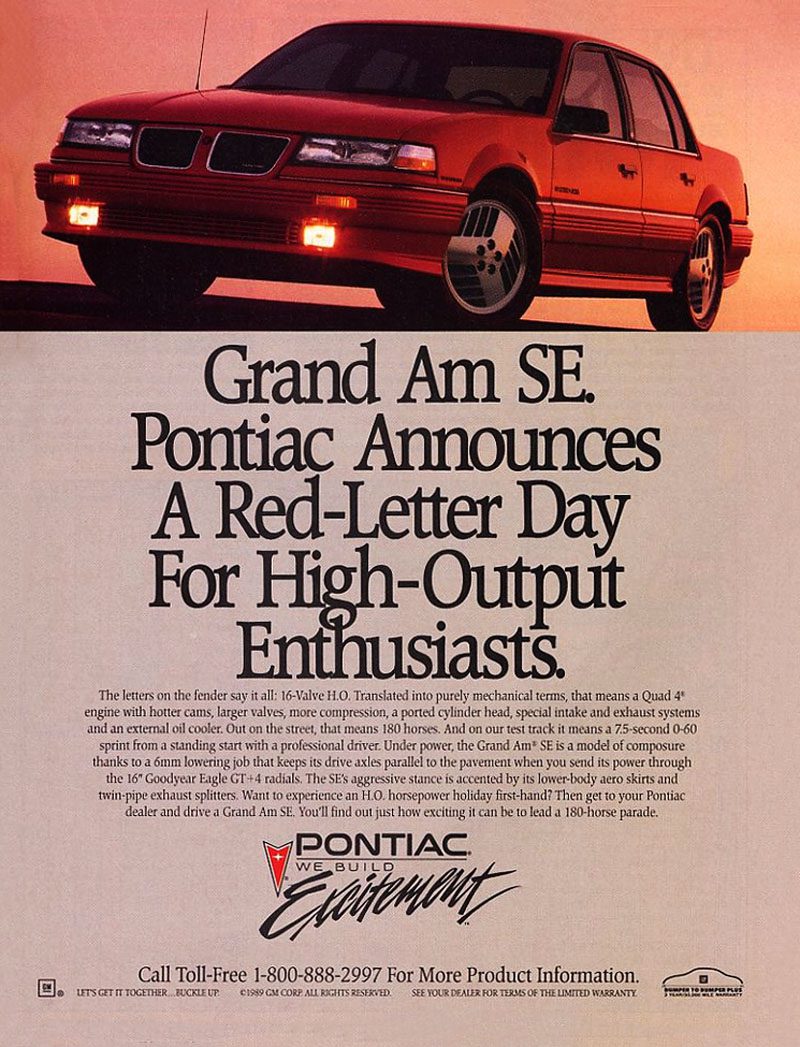Strolling the stroll, form of.
It was time for Pontiac to stroll the stroll. Having claimed for the reason that automotive’s inception that the Grand Am was infused with the identical know-how and character as advantageous European fashions of comparable dimensions, Pontiac was lastly in a position to put its cash the place its mouth was. Nicely, form of.
1989 Pontiac Grand Am
Grand Am SE
New as a compact automotive for 1985—the identify had been utilized to quite a few Pontiac fashions prior—the Grand Am had proved to be a scorching vendor for the model. Credit score the ‘Ams arguably sporty design and reasonably priced lineup, and disrespect the automotive’s low-cost inside and mediocre efficiency. Atop the trim-level mountain was the SE, which till 1989 had been powered by a modestly attention-grabbing 3.0-liter V6 produced by Buick. The slow-revving pushrod mill churned out simply 125 horsepower, however an inexpensive quantity of torque, making the automotive fast sufficient for stoplight drag-race tomfoolery.
Engines
For a interval, a turbocharged 2.0-liter engine was inserted into the Grand Am lineup, however it’s energy supply was peaky, and the motor was famously unreliable.

Quad 4
Enter the “high-output” Quad 4, a completely fashionable—in idea—4-cylinder engine that includes a 16-valve overhead-cam (OHC) cylinder head, and surprisingly excessive compression ratio. New for 1989, the LG0 (Common Motor’s inner product code) engine produced 180-185 horsepower and was mated completely to a 5-speed guide transmission. Of us searching for the comfort of an automated had been downgraded to a 160-horse model of the Quad 4 engine, internally dubbed LD2 by Common Motors. Neither the LG0 or LD2 might be had in any Grand Am trim stage however the SE. Notice that the LG0 required premium fuel, which can have restricted its enchantment. The LD2, nevertheless, ran simply advantageous on regular-grade gas, per Pontiac.
Efficiency
And with its new engine, the Grand Am lastly had—not less than on paper—the specs anticipated of a European-car wannabe. That stated, the LG0 engine was one thing of a disappointment, although not for its efficiency.
Whereas buff books of the day had been reporting spectacular 0-60 mph occasions of round 7.0 seconds for LG0 geared up Grand Ams, critiques of the engine weren’t particularly constructive. Although sturdy, the LG0 was famously loud and coarse sounding, and customarily tough total. This was the antithesis of small German engines of the period, which had been famously refined.
Reliability Points
Making issues worse, the LG0 engine was stricken by reliability issues, together with:
- Head-gasket failures
- Timing-chain tensioner points
- Extreme oil consumption
- Cooling system points
- Ignition-system failures
This at a time when German automobiles had been famed for his or her reliability.
Advertising and marketing
Supplied from 1989 to 1991, the high-output Quad 4 engines largely did not place the Grand Am as any form of budget-friendly German-car different. Nonetheless, with its racy—arguably gaudy—design, and consumer-friendly pricing, the Grand Am continued to promote like hotcakes, even when the know-how boasted of within the advert seen right here was deeply flawed.
Iron Duke
Most Grand Ams got here with GM’s ubiquitous, and customarily dependable, Iron Duke 4-cylinder mill. The innocent engine was greatest recognized for being cheap easy in operation, and in addition gas environment friendly. And whereas boring, the Iron Duke stored most Grand Am homeowners fairly completely happy.
And whereas the Quad 4 experiment within the Grand Am fell flat, variations of the engine would go on to larger horsepower rankings, and even some racing success in variations of the Oldsmobile Achieva.
Hearken to the Automotive Stuff Podcast
1989 Pontiac Grand Am Footage
Click on beneath for enlarged pictures
Client Information Automotive Stuff Podcast Episode 272: 2025 Client Information Finest Buys



